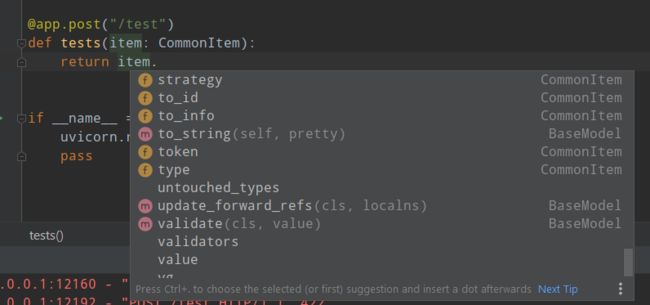全面拥抱FasiApi ——三大参数及验证
前几天写了一篇关于 FastApi 进阶的多应用程序管理蓝图APIRouter,可能对于有些没有基础的朋友看起来会有点懵,所以后面会按照由浅及深的顺序进行更新,记得关注噢
先看下 FastAPI 有哪些突出特点,官网介绍如下:
快速:非常高的性能,性能可与NodeJS和Go相媲美(感谢Starlette 和 Pydantic)。现有最快的Python框架之一。
快速编码:将功能开发速度提高约200%至300%*。
更少的错误:减少约40%的人为错误(开发人员)。
直观:强大的编辑器支持,程序调试时间更少。
简易:易于使用和学习,减少阅读文档的时间。
短:最小化重复代码,每个参数声明中的多个功能,减少编码错误。
健壮:获取可用于生产的代码。具有自动交互式的 API 文档。
基于标准:基于(并完全兼容)API 的开放标准:OpenAPI(以前称为Swagger)和JSON Schema。
前面说过 FastApi 的一大特点是基于标准的 Python 3.6类型声明,兼具参数校验功能,这一切都要归功于 Pydantic
路径参数
路径参数即 url 路径参数,可以使用 Python 格式字符串相同语法声明路径“参数”或“变量”,例如:
from fastapi import FastAPI
app = FastAPI()
@app.get("/items/{item_id}")
async def read_item(item_id: int, q: str = None):
return {"item": item_id, "q": q}
path 参数的值 item_id 将作为参数传递给视图函数,运行命令:
uvicorn 文件名:app
默认端口是 8000,也可以指定 host 和 port , --host=0.0.0.0 --port=8008
运行之后,在浏览器种打开 http://127.0.0.1:8000/items/1,可以看到响应:
{"item":1,"q":null}
其中 item_id 被声明为 int 类型,q 为 可选参数,默认为None,所以响应中的 q 是 None
当我们通过 http://127.0.0.1:8000/items/test 去访问的时候, 可以看到一个非常友好的错误响应
{
"detail": [
{
"loc": [
"path",
"item_id"
],
"msg": "value is not a valid integer",
"type": "type_error.integer"
}
]
}
因为 path 参数 item_id 的值是 “test” 不能转为 int,这就是参加验证
查询参数
查询参数也是带在 url 地址中的,是 url 中位于 ?之后的一组键值对,以 & 字符分隔,这对爬虫朋友来说再熟悉不过了,比如下面的请求参数
data = {"test": 1, "name": "Python编程与实战"}
response = requests.get(url, params=data)
以 关键字参数 params 传过去的就是查询参数,你可以将其中的 response.url 打印出来即可看到 ?之后的键值对参数
那么在服务端 FastApi 如何来接收这种参数呢? 请看代码
from fastapi import FastAPI
app = FastAPI()
fake_items_db = [{"item_name": "Foo"}, {"item_name": "Bar"}, {"item_name": "Baz"}]
@app.get("/items/")
async def read_item(skip: int = 0, limit: int = 10):
return fake_items_db[skip : skip + limit]
运行后输入地址:http://127.0.0.1:8000/items/?skip=0&limit=10
查询参数为:
- skip:值为 0
- limit:值为 10
注意这两个参数都带有默认值,可以选择只传一个
可选参数
同样,您可以通过将可选查询参数的默认值设置为来声明可选查询参数 None
from fastapi import FastAPI
app = FastAPI()
@app.get("/items/{item_id}")
async def read_item(item_id: str, q: str = None):
if q:
return {"item_id": item_id, "q": q}
return {"item_id": item_id}
必需查询参数
将上面代码中的 q: str 去掉 None,则 q 变成了必须查询参数,也就是必传的,否则会提示错误
{
"detail": [
{
"loc": [
"query",
"q"
],
"msg": "field required",
"type": "value_error.missing"
}
]
}
给大伙总结一下,在实际代码中可能会用到必需参数,默认参数,可选参数,如下:
from fastapi import FastAPI
app = FastAPI()
@app.get("/items/{item_id}")
async def read_user_item(item_id: str, needy: str, skip: int = 0, limit: int = None):
item = {"item_id": item_id, "needy": needy, "skip": skip, "limit": limit}
return item
在这种情况下,有3个查询参数:
- needy,是必需的 str 。
- skip,int 默认值为 0。
- limit,可选的 int。
其中还有一个是路径参数:item_id, str 类型
请求体参数
要发送请求正文,必须使用一个:POST, PUT,DELETE或PATCH,需导入 Pydantic 的 BaseModel
from fastapi import FastAPI
import uvicorn
from pydantic import BaseModel
app = FastAPI()
class CommonItem(BaseModel):
token: str
message_id: str
to_id: str
from_info: str
strategy: int or str = 0 # 默认为0,可不传该参数,但是不能传空字符串
type: str or int # str 和 int 类型都支持
from_id: str
to_info: str
content: str = None
@app.post("/test")
async def tests(item: CommonItem):
return item
可以看到,创建了一个 CommonItem 模型,有了声明的这个模型,可以实现以下功能:
- 以 JSON 读取请求的正文
- 根据声明的类型,自动对参数进行转换
- 验证数据,如果数据无效,它将返回一个清晰的错误,指出错误数据的确切位置和来源
- 在参数中接收收到的数据 item,并能获取所有属性及所有编辑器的支持
同时,FastApi 可以自动帮我们识别请求 body 参数, 路径参数以及查询参数,并准确的获取参数数据。例如以下代码:
from fastapi import FastAPI
from pydantic import BaseModel
class Item(BaseModel):
name: str
description: str = None
price: float
tax: float = None
app = FastAPI()
@app.put("/items/{item_id}")
async def create_item(item_id: int, item: Item, q: str = None):
result = {"item_id": item_id, **item.dict()}
if q:
result.update({"q": q})
return result
上述代码,参数将被自动识别:
- item_id,: 路径参数
- q: 参数是一个的单一类型(如int,float,str,bool,等等)将被解释为一个查询参数
- item: 参数声明为 Pydantic 模型的类型,则将被解释为请求 body

